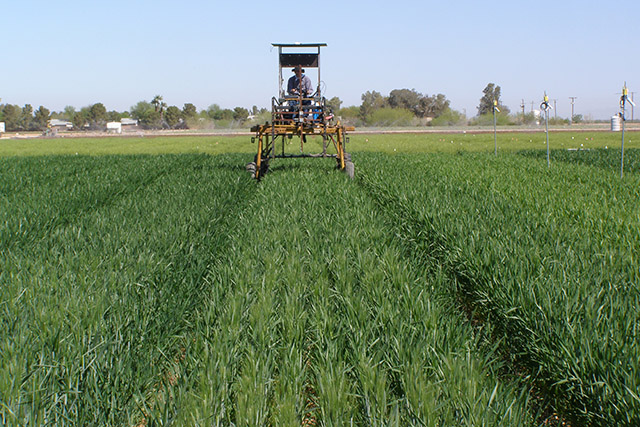By Dennis O’Brien, USDA-ARS Office of Communications.
Irrigation is a must for wheat producers in Arizona’s hot, dry climate, but most of the water comes from the Colorado River, and that supply is being depleted by the long-term drought.
Fertilizer is getting more expensive, and when too much fertilizer and water are applied, the excess amounts can percolate too deeply into the soil and contaminate the groundwater.
Maximizing yields with as little water and fertilizer as possible is a top priority for today’s Arizona wheat growers.
Optimal irrigation levels for wheat means hitting a sweet spot: Applying abundant water will increase yields, but overwatering wheat as the grain is filling in can reduce the protein content and potentially reduce the value of the crop.
 |
|
USDA-Agricultural Research Service soil scientist Kevin Bronson applies nitrogen fertilizer to a crop in Maricopa, Ariz. |
Kevin Bronson, a soil scientist at the U.S. Arid Land Agricultural Research Center in Maricopa, Arizona, conducts research that can guide Arizona wheat producers on irrigation and fertilizer practices that maximize yield and grain quality. The advice is timely: advances in overhead sprinkler systems and other technologies are giving farmers more control over how much water they use.
Bronson and his colleagues grew durum wheat for 2 years using 5 fertilizer rates and 10 irrigation rates to compare yields and how efficiently the wheat used nitrogen. They focused on durum wheat, a $131 million crop in Arizona that is used in pastas and sold at premium prices. Durum wheat is also an important crop in several other southwestern states.
The scientists used daily weather data to calculate a base irrigation rate. They irrigated two to four times a week with a mobile overhead sprinkler system. Plant samples were analyzed for nitrogen content to determine how efficiently the plants used nitrogen fertilizer. The scientists calculated optimal irrigation and fertilizer rates based on total yields. They also calculated an “economic rate” that factored in fertilizer costs and market prices for durum wheat.
The researchers found that the more water and fertilizer they applied, the higher the yields. Going beyond optimum water and fertilizer rates produced taller wheat plants that tended to lodge, or fall over, which cut into yields.
For maximum yield, the optimal fertilizer rate was 225 pounds of nitrogen per acre. But they also found that when they factored in fertilizer costs, more isn’t always better. The economic rate, with the fertilizer cost included, was about 175 pounds of nitrogen per acre.
The optimal irrigation level was about 20 inches of water throughout the growing season. Going beyond that causes some of the water and nitrogen to percolate too deeply into the soil.
The results also showed that an impressive 70-90 percent of the applied nitrogen was used by the crop irrigated with overhead sprinklers. That compares to nitrogen use rates of 50 percent or less seen in many row crops irrigated with surface flooding, Bronson says.
Growers in Arizona are gradually shifting away from surface flooding and adopting the type of overhead sprinklers used in the study. Bronson hopes that the results, published in the March 2016 issue of Field Crops Research, will encourage more growers to start using overhead sprinkler systems.
“Overhead sprinklers are more precise, ensure that less water is wasted, and can save on fertilizer, because a carefully watered crop is more efficient at using the nitrogen fed to it,” he explains.





